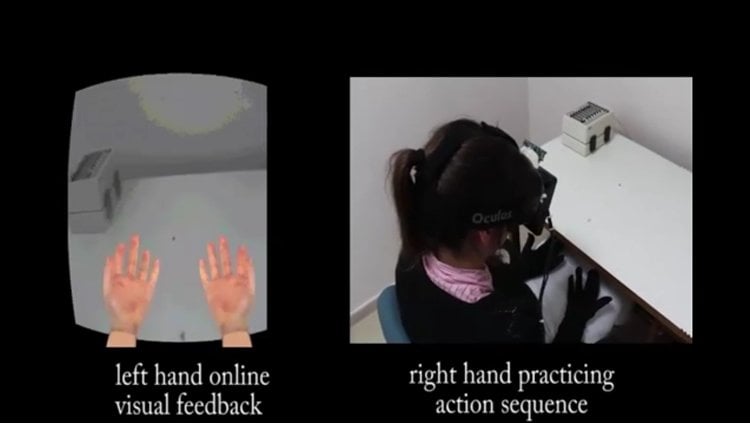Summary: Findings using virtual reality could help to improve treatments for people with limited hand strength.
Source: Cell Press.
The saying goes that “your left hand doesn’t know what your right hand is doing,” but actually, your left hand is paying more attention than you’d think. Researchers at Tel-Aviv University found that when people practiced finger movements with their right hand while watching their left hand on 3D virtual reality headsets, they could use their left hand more efficiently after the exercise. The work, appearing December 13 in Cell Reports, provides a new strategy to improve physical therapy for people with limited strength in their hands.
“We are tricking the brain,” says lead author Roy Mukamel, a professor of psychology at Tel Aviv University in Israel. “This entire experiment ended up being a nice demonstration about how to combine software engineering and neuroscience.”
After completing baseline tests to assess the initial motor skills of each hand, 53 participants strapped on virtual reality headsets, which showed simulated versions of their hands. During the first experiment, the participants completed a series of finger movements with their right hand while the screen showed their virtual left hand moving instead. Next, the participants put a motorized glove on their left hand, which moved their fingers to match the motions of the right hand. While this occurred, the headsets again showed their virtual left hand moving instead of their right.
After analyzing the results, the researchers discovered that the left hand’s performance significantly improved (i.e., had more precise movements in a faster amount of time) when the screen showed the left hand. But the most notable improvements occurred when the virtual reality screen showed the left hand moving while the motorized glove moved the right hand in reality.

The researchers also used fMRI to track which brain structures were activated during the experiments in 18 of the participants. The scientists noted that one section of the brain, called the superior parietal lobe, was activated in each person during training. They also discovered that the level of activity in this brain region was correlated to the level of improved performance in the left hand–the more activity, the better the left hand performed.
“Technologically these experiments were a big challenge,” says Mukamel. “We manipulated what people see and combined it with the passive movement of the hand to show that our hands can learn when they’re not moving under voluntary control.”
The researchers are optimistic that this research can be applied to patients in physical therapy programs who have lost the strength or control of their hands. “We need to show a way to obtain high-performance gains relative to other traditional types of therapies,” says Mukamel. “If we can train one hand without voluntarily moving it and still show significant improvements in the motor skills of that hand, then that’s the ideal.”
Funding: This work was supported through the Sagol School of Neuroscience and School of Psychological Sciences at Tel-Aviv University in Israel.
Source: Michaela Kane – Cell Press
Image Source: NeuroscienceNews.com image is credited to Ossmy and Mukamel/Cell Reports 2017
Original Research: Full open access research for “Neural Network Underlying Intermanual Skill Transfer in Humans” by Ori Ossmy and Roy Mukamel in Cell Reports. Published online December 13 2016 doi:10.1016/j.celrep.2016.11.009
[cbtabs][cbtab title=”MLA”]Cell Press “Your Left Hand Knows What Your Right Hand is Doing.” NeuroscienceNews. NeuroscienceNews, 13 December 2016.
<https://neurosciencenews.com/left-right-hand-5733/>.[/cbtab][cbtab title=”APA”]Cell Press (2016, December 13). Your Left Hand Knows What Your Right Hand is Doing. NeuroscienceNew. Retrieved December 13, 2016 from https://neurosciencenews.com/left-right-hand-5733/[/cbtab][cbtab title=”Chicago”]Cell Press “Your Left Hand Knows What Your Right Hand is Doing.” https://neurosciencenews.com/left-right-hand-5733/ (accessed December 13, 2016).[/cbtab][/cbtabs]
Abstract
Neural Network Underlying Intermanual Skill Transfer in Humans
Highlights
•Unimanual training also enhances performance in the untrained hand (cross-education)
•Real-time manipulation of visual feedback enhances magnitude of cross-education
•Yoking movement of untrained to trained hand further increases cross-education
•Functional connectivity with SPL during training predicts cross-education
Summary
Physical practice with one hand results in performance gains of the other (un-practiced) hand, yet the role of sensory feedback and underlying neurophysiology is unclear. Healthy subjects learned sequences of finger movements by physical training with their right hand while receiving real-time movement-based visual feedback via 3D virtual reality devices as if their immobile left hand was training. This manipulation resulted in significantly enhanced performance gain with the immobile hand, which was further increased when left-hand fingers were yoked to passively follow right-hand voluntary movements. Neuroimaging data show that, during training with manipulated visual feedback, activity in the left and right superior parietal lobule and their degree of coupling with motor and visual cortex, respectively, correlate with subsequent left-hand performance gain. These results point to a neural network subserving short-term motor skill learning and may have implications for developing new approaches for learning and rehabilitation in patients with unilateral motor deficits.
“Neural Network Underlying Intermanual Skill Transfer in Humans” by Ori Ossmy and Roy Mukamel in Cell Reports. Published online December 13 2016 doi:10.1016/j.celrep.2016.11.009






